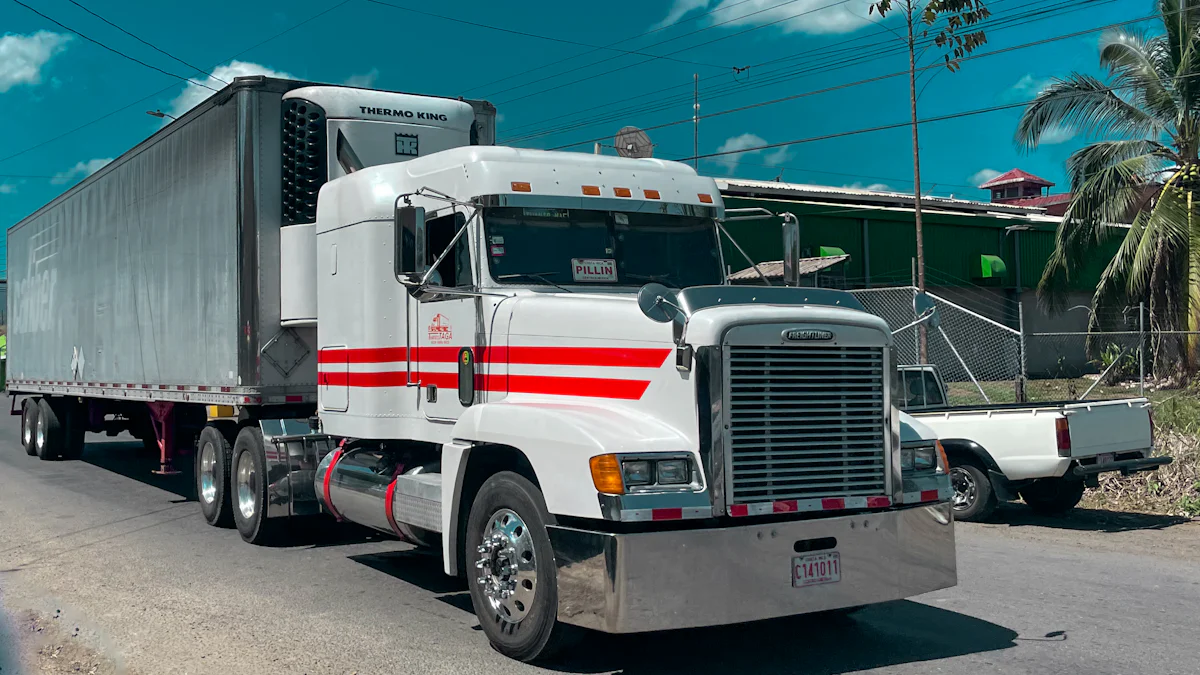Domestic Trucking Solutions: A Comparative Analysis

Domestic trucking plays a crucial role in the logistics industry. In 2022, the trucking industry generated an impressive $940.8 billion in gross freight revenues. This highlights the significance of choosing the right trucking solution. Businesses need a comparative analysis to make informed decisions. Understanding the advantages and disadvantages of different options helps companies optimize their logistics strategies.
Overview of Domestic Trucking Solutions
Full Truckload (FTL) Shipping
Definition and Key Features
Full Truckload (FTL) Shipping involves transporting goods that fill an entire truck. Businesses use FTL shipping for large shipments that require a dedicated vehicle. This method ensures that the cargo remains on one truck from the point of origin to the destination.
Advantages
FTL shipping offers several benefits. The primary advantage is faster transit times. Since the truck carries only one shipment, there are no stops for additional pickups or deliveries. This method also provides more control over the shipment. Businesses can track the truck and ensure the goods arrive on time. FTL shipping reduces the risk of damage because the cargo remains in the same truck throughout the journey.
Disadvantages
Despite its advantages, FTL shipping has some drawbacks. The cost can be higher compared to other methods. Smaller businesses with less freight may find FTL shipping less cost-effective. Additionally, finding available trucks can be challenging during peak seasons.
Less Than Truckload (LTL) Shipping
Definition and Key Features
Less Than Truckload (LTL) Shipping combines shipments from multiple businesses into one truck. This method is ideal for small to medium-sized shipments that do not require a full truckload. LTL shipping helps businesses save on costs by sharing truck space with other shippers.
Advantages
LTL shipping offers cost savings as businesses pay only for the portion of the truck they use. This method provides flexibility for smaller shipments. LTL shipping also reduces the environmental impact by maximizing truck space and reducing the number of trips needed.
Disadvantages
LTL shipping has some disadvantages. The transit time can be longer because the truck makes multiple stops for pickups and deliveries. There is a higher risk of damage since the cargo gets handled more frequently. Additionally, tracking shipments can be more complex due to the involvement of multiple parties.
Intermodal Trucking
Definition and Key Features
Intermodal Trucking involves using multiple modes of transportation, such as trucks, trains, and ships, to move goods. This method leverages the strengths of each transportation mode to optimize efficiency and cost.
Advantages
Intermodal trucking offers several benefits. It provides cost savings by utilizing the most efficient transportation modes for different segments of the journey. This method also reduces fuel consumption and lowers carbon emissions. Intermodal trucking enhances reliability by providing alternative routes in case of disruptions.
Disadvantages
Intermodal trucking has some limitations. The coordination between different transportation modes can be complex. This method may involve longer transit times due to the transfers between modes. Additionally, businesses need to manage multiple carriers, which can complicate logistics.
Key Factors to Consider When Choosing a Domestic Trucking Solution

Cost Efficiency
Factors Affecting Cost
Cost efficiency stands as a crucial factor when selecting a domestic trucking solution. Several elements influence the overall cost. Fuel prices directly impact transportation expenses. Labor costs, including driver wages and benefits, also play a significant role. Maintenance and repair costs for vehicles add to the total expense. Additionally, tolls and permits can increase costs, especially for long-distance routes.
Cost Comparison Between FTL, LTL, and Intermodal
Comparing costs between Full Truckload (FTL), Less Than Truckload (LTL), and Intermodal solutions reveals distinct differences. FTL shipping often proves more economical for high-volume shipments. The price-per-mile ratio decreases with larger loads. LTL shipping, on the other hand, allows businesses to share transportation costs with other shippers. This method works well for smaller shipments but may involve additional handling fees. Intermodal trucking leverages multiple transportation modes, offering potential cost savings through optimized routes and fuel efficiency.
Delivery Speed and Reliability
Factors Affecting Delivery Speed
Delivery speed depends on various factors. Distance between origin and destination plays a primary role. Traffic conditions and weather can cause delays. The type of trucking solution chosen also impacts speed. FTL shipping typically offers faster transit times due to dedicated routes. LTL shipping might take longer because of multiple stops for pickups and deliveries. Intermodal trucking involves transfers between different transportation modes, which can extend delivery times.
Reliability Comparison
Reliability varies among FTL, LTL, and Intermodal solutions. FTL shipping provides high reliability with fewer stops and less handling. This method ensures that goods stay on the same truck throughout the journey. LTL shipping involves more handling, increasing the risk of damage or delays. However, reputable carriers can mitigate these risks. Intermodal trucking offers reliability through alternative routes in case of disruptions. Coordination between different modes requires careful management to maintain reliability.
Flexibility and Scalability
Importance of Flexibility
Flexibility in domestic trucking solutions allows businesses to adapt to changing needs. Companies may face fluctuations in shipment sizes or delivery schedules. A flexible solution accommodates these variations without compromising efficiency. Flexibility also enables businesses to respond quickly to market demands or unexpected events.
Scalability of Different Solutions
Scalability differs among FTL, LTL, and Intermodal options. FTL shipping scales well for large shipments, providing dedicated transportation. However, smaller businesses might find it less scalable due to higher costs for partial loads. LTL shipping offers excellent scalability for varying shipment sizes. Businesses can adjust their shipping needs without committing to a full truckload. Intermodal trucking provides scalability by combining different transportation modes. This method adapts to both small and large shipments, optimizing routes and costs.
Case Studies and Real-World Examples

Successful Implementation of FTL
Case Study 1
Produce Grower Optimizes Network and Delivery Consistency
A produce grower faced challenges with network support and delivery consistency. By utilizing Schneider's Full Truckload (FTL) services, the grower optimized its logistics network. The dedicated trucks ensured timely deliveries, which improved customer satisfaction. The grower experienced business growth and a better bottom line.
Lessons Learned
Network Optimization: Dedicated FTL services can enhance network efficiency.
Delivery Consistency: Reliable FTL services improve delivery times and customer satisfaction.
Business Growth: Optimized logistics contribute to overall business growth.
Successful Implementation of LTL
Case Study 2
Tire Manufacturer Saves Money with Market Index Pricing
A tire manufacturer struggled with unpredictable freight costs. By adopting Schneider's Less Than Truckload (LTL) services and Market Index Pricing, the manufacturer saved money. Sharing truck space with other shippers reduced costs significantly. The manufacturer achieved better cost control and improved financial performance.
Lessons Learned
Cost Savings: LTL services with Market Index Pricing offer substantial cost reductions.
Financial Performance: Better cost control leads to improved financial outcomes.
Flexibility: LTL services provide flexibility for varying shipment sizes.
Successful Implementation of Intermodal Trucking
Case Study 3
Achieve Savings and Sustainability with Bulk Express Intermodal
A materials science company aimed to optimize its supply chain and sustainability goals. By leveraging Schneider's Bulk Intermodal service offerings, the company moved closer to its sustainability targets. The intermodal solution improved supply chain efficiency and reduced carbon emissions. The company also benefited from cost savings through optimized routes.
Lessons Learned
Sustainability Goals: Intermodal trucking helps achieve environmental objectives.
Supply Chain Efficiency: Combining different transportation modes enhances efficiency.
Cost Savings: Optimized routes and fuel efficiency lead to significant cost reductions.
Domestic trucking solutions offer diverse benefits and challenges. Businesses must assess specific needs to choose the right option. Consider shipment size, distance, costs, reliability, and flexibility. Evaluate potential carriers based on these factors.
Actionable Advice:
Understand Your Needs: Identify shipment size and frequency.
Evaluate Costs: Compare FTL, LTL, and Intermodal pricing structures.
Ensure Reliability: Look for carriers with a strong track record.
Prioritize Flexibility: Choose solutions that adapt to changing demands.
Careful consideration ensures optimal logistics strategies and business success.
See Also
Analyzing the Future of Less-Than-Truckload Freight
Affordable Transportation Management: Your Budget's Ally
Unraveling AI's Potential in Logistics
Revealing Cross-Border E-commerce's Supplier Relationship Innovations
